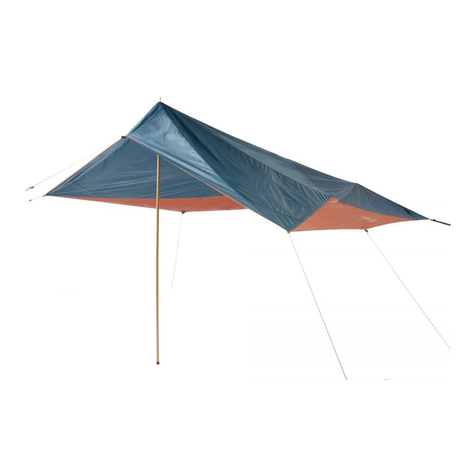
DO NOT USE A DAMAGED BACKPACK
• DO check the condition of the backpack before each use.
• DO check to assure all buckles snaps, straps, and adjustments
are secure before each use.
• DO NOT use pack if the frame, fabric, straps or buckles are damaged.
• DO NOT use pack if pack is damaged in any way.
• DO NOT leave (store) a pack in direct sunlight. Ultra-violet light
will cause materials to weaken and fade.
• For assistance in repairing your pack or answering any questions,
call Kelty Customer support staff; toll free at 866-349-7225
(866-FIX-PACK).
SAFETY INFORMATION
-IMPORTANT-
• Read, and follow, all instructions before using this backpack!
• Failure to follow these warnings could result in a potentially
hazardous situation which, if not avoided could cause rapid fatigue,
death, serious injury or permanent disability to you or others.
CARE AND CLEANING
1. Brush off loose dirt with a dry brush.
2. As needed, wipe out the inside with
a damp sponge and mild soap.
3. Rinse only, if possible. Use cold
water and a sponge or rinse in a
tub without soap.
4. Machine wash in front-loading unit
(DO NOT use machine with agita-
tor, agitator could cause damage
not covered under warranty) with
cold water and mild soap (Ivory
Flakes, Woolite, Sport Wash, Etc.)
Not detergents.
5. DO NOT soak in soapy water, it
may cause damage to the coated
fabric.
6. Rinse thoroughly to eliminate soap
residue.
7. DO NOT use a dryer, air dry only.
8. Always store in a cool, dry area.
WARNING
THIS BACKPACK MAYAFFECT YOUR
COORDINATION AND BALANCE
• Before use, DO familiarize yourself with the added weight of the
pack and contents.
• DO use a spotter to assist when hoisting pack onto shoulders.
• When strapping items such as skis to pack, be aware that they
can catch on overhead obstructions causing you to lose your
balance and fall.
• DO NOT overload pack, don’t carry more weight than you can
manage.
CAUTION
WARNING
PROTECT YOURSELF
• DO NOT place backpack near a campfire, stove or any open flame.
• Only carry liquid fuel in containers approved for such use and make
sure they are tightly sealed before placing in a pack.
SAFETY INFORMATION
2
SAFETY INFORMATION
3
ZIPPER CARE
1. Keep loose threads
trimmed.
2. Keep free from dirt.
3. Spray periodically with a
non-greasy, non-staining
silicone spray designed
for fabrics.
4. To prevent salt water
corrosion on zipper
pulls, make sure you
rinse with clear water
after exposure.
WARNING indicates a potentially hazardous situation which, if
not avoided, could result in death or serious injury.
CAUTION indicates a potentially hazardous situation which, if not
avoided, could result in property damage.
!
!
!
!
!























